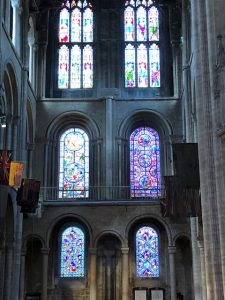






Earlier this month, I was privileged to be invited to speak at Goethe University in Frankfurt, Germany.
My address, Understanding and Responding to Intimate Partner Violence: Is Religion Part of the Problem or Part of the Solution? examined the various ways that religion helps or hinders a woman of faith as she seeks safety, healing and wholeness in the aftermath of abuse in an intimate partner relationship.
As part of my address, I showed the various panes of glass that feature as part of the RAVE website’s Stained Glass Story of Abuse. I talked about the beauty of relationships, the despair, chaos and pain that abuse creates, as well as the long journey to find your voice and your confidence after it has been shattered by violence. As is often my experience, the Stained Glass Story of Abuse draws in the audience. The vibrant colours, the shards of glass, the smashing of the intact pane and the reconfigured display of an abused woman’s life all speak much more clearly and powerfully than I ever could. The stained glass portrait evokes emotion in the women and men who view it and it allows many of us to experience visually the reality of abuse and the devastation that it creates.
In the discussion that followed my talk, many questions were raised about how we hold religious leaders accountable for their response to those who seek their help, abused and abuser alike. The audience had little trouble seeing religion as part of the problem. They struggled more with the notion that religion could be part of the solution.
We all need to be accountable for what we do and say to those whose lives have been impacted by domestic violence. One way this occurs in a professional context is by encouraging a collaborative community response to abuse. Here religious leaders can be invited to participate and learn best practices and secular service providers can be invited to think about the role of religion in the lives of many survivors and perpetrators. In some contexts, this is a big request.
After I left Germany, I traveled on to England and spent some time in Cambridge. One day we toured the expansive cathedral in Ely. What a showcase of stained glass! With the noon sun shining through the cathedral windows, we, the visitors, were treated to a colourful rendering of the life of Jesus and other Biblical stories. My mind was drawn to the fact that for hundreds of years, worshipers see and learn these God-inspired stories without reading a word. The stained glass images speak to the heart, provide comfort, and offer a challenge.
To comfort and to challenge—that also is central to the work we do here at the RAVE Project.
Travel helps me to appreciate the beauty and diversity of our world and each time I return to my beloved home I am reminded that when abuse strikes there is no home.
Nancy Nason-Clark, November 22, 2019